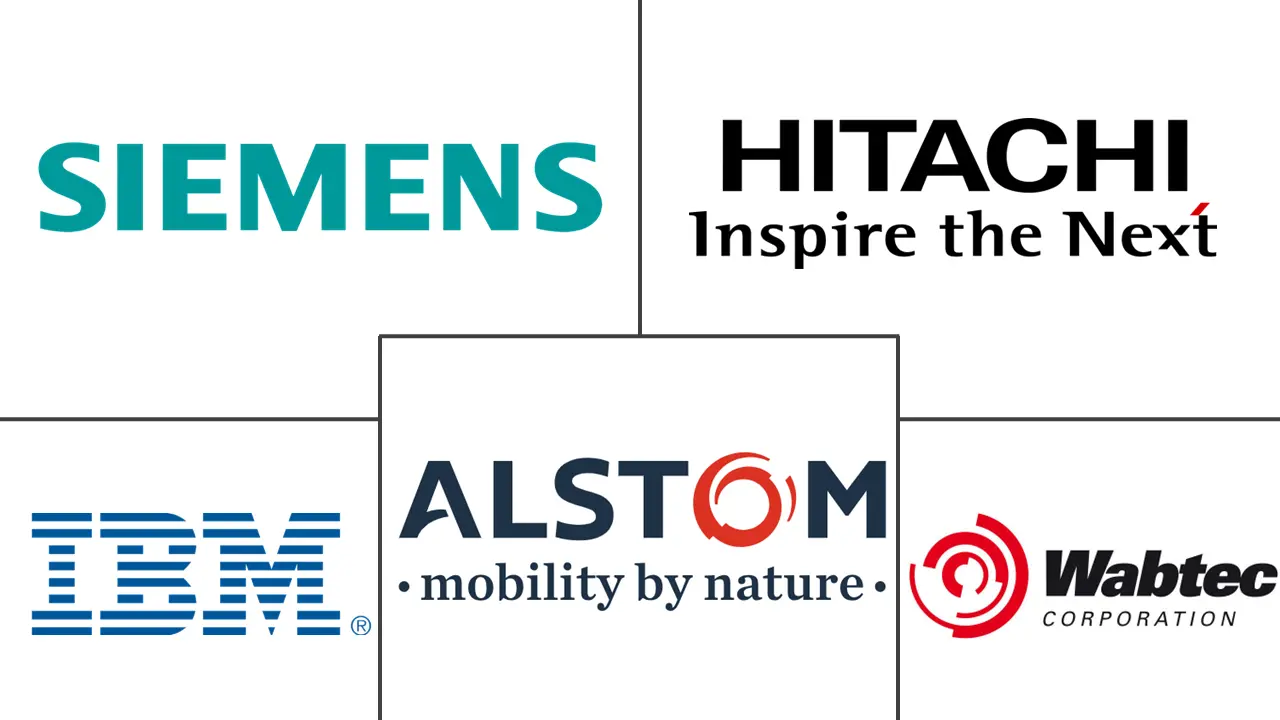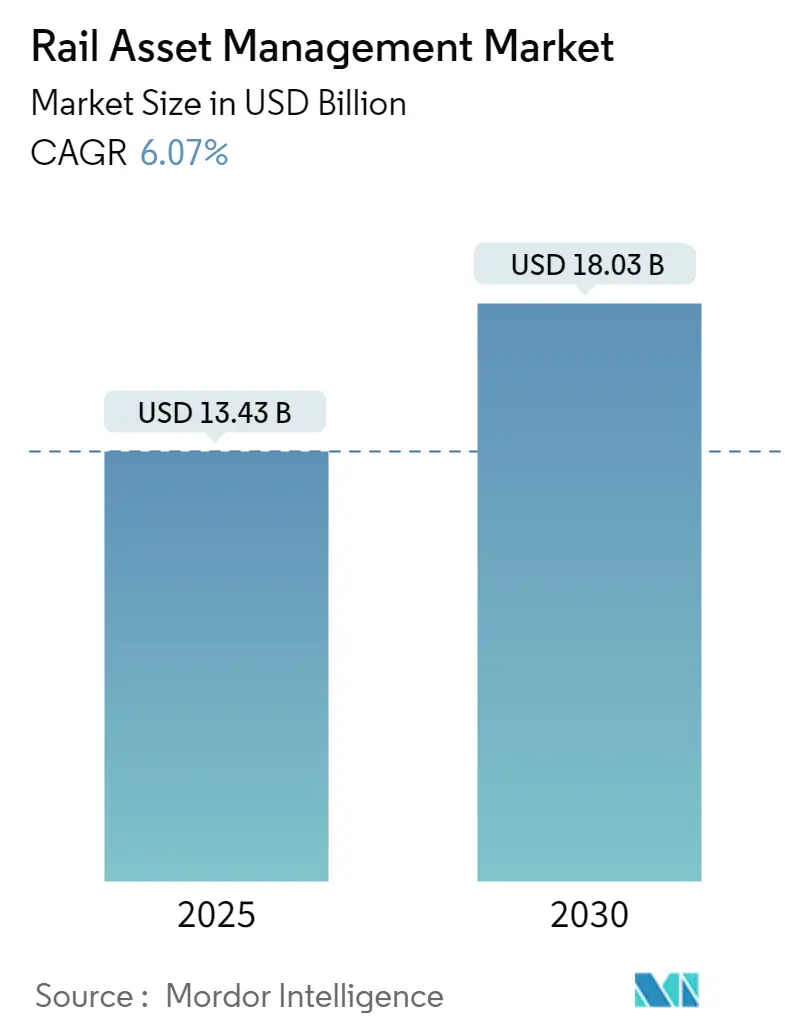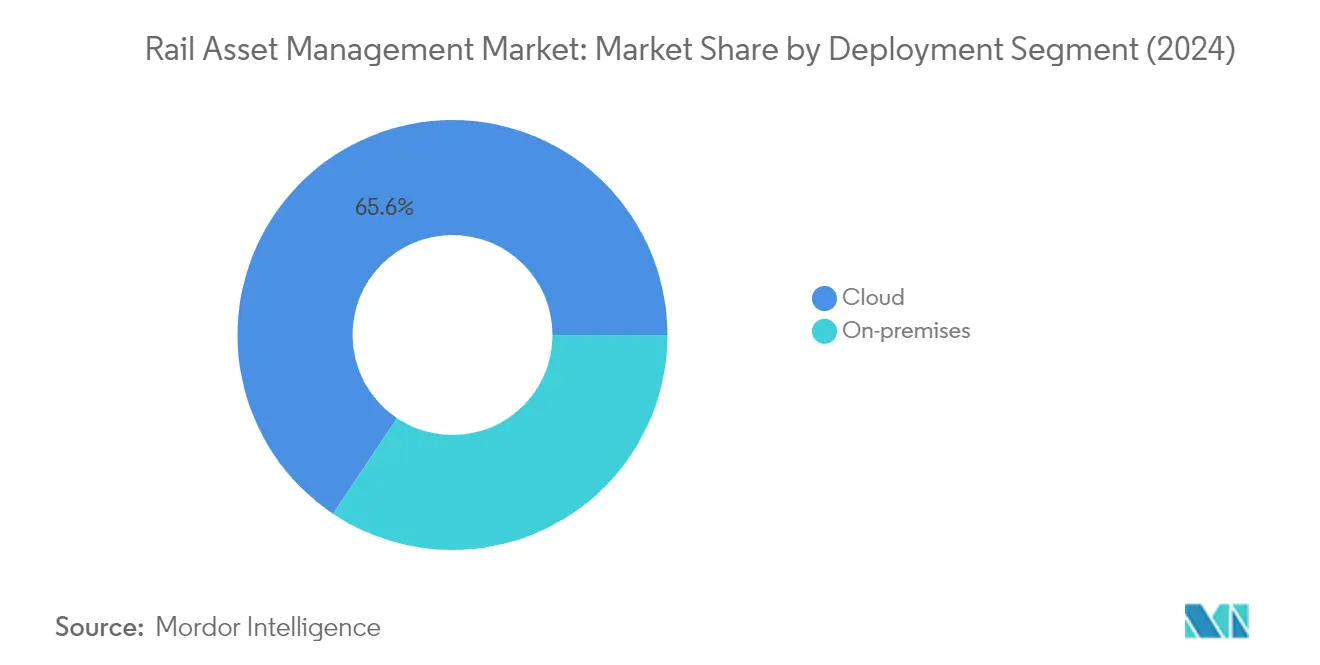Rail Asset Management Market Analysis
The Rail Asset Management Market size is estimated at USD 13.43 billion in 2025, and is expected to reach USD 18.03 billion by 2030, at a CAGR of 6.07% during the forecast period (2025-2030).
The rail asset management industry is experiencing a significant transformation driven by technological advancement and digital innovation. Rail operators worldwide are increasingly adopting sophisticated asset management solutions that incorporate artificial intelligence, the Internet of Things (Rail IoT), and machine learning capabilities to enhance operational efficiency. These technologies enable real-time monitoring of rail assets, predictive maintenance planning, and data-driven decision-making, fundamentally changing how rail infrastructure is managed and maintained. The integration of railway digital twin technology has emerged as a particularly noteworthy trend, allowing operators to create virtual replicas of physical assets for simulation and optimization purposes.
The industry is witnessing substantial investments in infrastructure modernization and digital transformation initiatives. In February 2023, France announced an ambitious plan to invest €100 billion in rail transport by 2040, focusing on expanding and upgrading its rail network. This trend is mirrored across other regions, with rail operators implementing advanced asset management systems to optimize their operations and improve service reliability. The emphasis on modernization extends beyond traditional infrastructure to encompass comprehensive digital solutions that manage entire rail networks more efficiently.
The market is experiencing a notable shift toward cloud-based deployment models and integrated asset management solutions. Rail operators are increasingly moving away from siloed systems toward comprehensive platforms that can manage both rolling stock and infrastructure assets through a single interface. This integration enables better coordination between different operational aspects, from maintenance scheduling to resource allocation. The trend is particularly evident in the adoption of smart maintenance solutions that combine sensor data, advanced analytics, and automation to optimize asset performance and reduce downtime. Rail predictive maintenance is becoming a cornerstone of these strategies, ensuring that potential issues are addressed before they lead to significant disruptions.
Environmental sustainability has emerged as a crucial factor shaping the rail asset management landscape. Rail operators are increasingly focusing on solutions that can help reduce energy consumption and minimize environmental impact. This has led to the development of sophisticated asset management systems that optimize energy usage through intelligent monitoring and control mechanisms. For instance, in April 2023, China's state railway reported a 6.6% increase in fixed-asset investment in the first quarter, with a significant portion directed toward developing sustainable and efficient rail infrastructure systems. These investments reflect the industry's commitment to environmental stewardship while maintaining operational excellence through advanced asset management solutions. The use of railway analytics further supports these efforts by providing insights into energy consumption patterns and identifying opportunities for improvement.
Rail Asset Management Market Trends
GROWING DEMAND FOR EFFECTIVE RAIL OPERATIONS
Rail transportation has emerged as a crucial solution for efficient mass transit, offering significant advantages in moving large volumes of goods and passengers over long distances. The sector's inherent benefits include higher capacity utilization, lower energy consumption per unit of freight or passenger, and reduced traffic congestion compared to other transportation modes. These operational efficiencies are further enhanced through the integration of advanced technologies, including automation, digitalization, and data analytics, which collectively improve asset management, enable predictive maintenance, optimize scheduling, and enhance safety measures. The implementation of rail maintenance software, sensor-based monitoring systems, and predictive analytics tools has revolutionized the industry by enabling better asset tracking, real-time performance monitoring, and data-driven decision-making.
The environmental advantages of rail transportation have become increasingly significant in the context of global sustainability goals. According to the International Energy Agency (IEA), in the Net Zero Scenario by 2030, electricity is projected to account for approximately two-thirds of the total final energy consumption in rail operations, with diesel and biodiesel accounting for the remaining portion. This transition towards more sustainable energy sources, coupled with trains' lower greenhouse gas emissions per ton-mile or passenger-mile, positions rail transportation as an environmentally responsible choice. The sector's commitment to sustainability is further demonstrated through the implementation of innovative technologies that optimize energy usage and reduce environmental impact, making rail operations an attractive solution for meeting both transportation needs and environmental objectives.
INCREASE IN GOVERNMENT INITIATIVES AND PUBLIC-PRIVATE PARTNERSHIP MODEL
Government initiatives and public-private partnerships (PPP) have become instrumental in driving the rail infrastructure management market's growth through substantial investments and collaborative projects. In February 2023, the French government announced a landmark investment plan of EUR 100 billion in rail transport by 2040, aimed at expanding and upgrading the rail network, including the launch of express commuter trains similar to the Paris RER system in major cities. Similarly, significant developments are occurring in emerging markets, as exemplified by the April 2023 partnership between the Siemens consortium and Gujarat Metro Train Corporation to implement advanced train electrification solutions, encompassing power supply, train electrification technology, and distribution systems.
The public-private partnership model has proven particularly effective in combining resources, expertise, and innovation required for effective rail infrastructure management. These partnerships facilitate the development and implementation of advanced technologies while sharing risks and responsibilities between public and private entities. The collaboration between government bodies and private sector expertise has led to more efficient project execution and improved service delivery. This approach has been particularly successful in developing comprehensive asset management strategies that incorporate modern technologies such as IoT sensors, artificial intelligence, and advanced analytics platforms, enabling more efficient monitoring and maintenance of rail infrastructure while optimizing operational performance.
RAPID URBANIZATION IN DEVELOPING AND UNDERDEVELOPED COUNTRIES
Rapid urbanization in developing and underdeveloped countries has created an unprecedented demand for efficient mass transit systems, particularly in the rail sector. The expansion of urban populations has necessitated the development of robust transportation infrastructure to address increasing mobility needs and reduce traffic congestion in growing metropolitan areas. This urbanization trend has led to significant investments in rail infrastructure, with countries developing both intracity metro systems and intercity rail connections to support their growing urban centers. The development of these rail networks requires sophisticated rail maintenance software solutions to ensure efficient operations, maintenance, and safety compliance.
The scale of infrastructure development is particularly evident in major developing economies. For instance, China's ambitious railway expansion program saw the addition of over 3,000 kilometers of new railway lines in 2022, including 2,500 kilometers of high-speed railways, demonstrating the massive scale of infrastructure development in response to urbanization. Similarly, India's extensive railway network, spanning over 67,000 kilometers, represents one of the largest rail systems globally, requiring comprehensive rail fleet management solutions to maintain and optimize its diverse array of assets, including tracks, bridges, signaling systems, rolling stock, and stations. These extensive networks demand sophisticated asset management systems to ensure efficient operations, maintenance scheduling, and safety compliance while supporting the growing transportation needs of rapidly urbanizing populations.
Segment Analysis: By Deployment
Cloud Segment in Rail Asset Management Market
The cloud deployment segment has emerged as the dominant force in the global rail asset management market, commanding approximately 66% market share in 2024, while also demonstrating the strongest growth trajectory. This substantial market position is primarily driven by the increasing adoption of cloud-based solutions among railway operators due to their inherent benefits in providing scalable and secure cloud-hosted software. Major global companies, including Trimble Inc., have been actively offering their rail asset management solutions as cloud-based software, enabling customers to adopt these systems without significant investment in IT infrastructure and associated maintenance costs. The segment's prominence is further reinforced by its ability to offer real-time data accessibility, enhanced collaboration capabilities, and cost-effective deployment options. Railway companies are increasingly recognizing the advantages of cloud deployment in terms of flexibility, scalability, and the ability to integrate advanced analytics and artificial intelligence capabilities, making it the preferred choice for modern rail asset management solutions.
On-Premises Segment in Rail Asset Management Market
The on-premises deployment segment continues to maintain its significance in the rail asset management market, particularly among organizations prioritizing direct control over their data and infrastructure. This deployment model remains crucial for railway enterprises that require enhanced security measures and complete control over their operational data. The segment's resilience is supported by its ability to provide reliable and secure solutions, allowing railway enterprises to maintain a superior level of control over their asset management systems. Many market vendors, including industry leaders such as Cisco, IBM, and Hitachi, continue to offer comprehensive on-premises deployment options with customized offerings to meet the specific requirements of railway operators. These solutions are particularly valued in applications requiring stringent security protocols, critical infrastructure protection, and compliance with specific regulatory requirements.
Segment Analysis: By Application
Rolling Stock Segment in Rail Asset Management Market
The rolling stock management market dominates the global rail asset management market, commanding approximately 60% of the market share in 2024. This significant market position is attributed to the increasing adoption of advanced strategies in rail predictive maintenance operations and real-time data collection and analysis across major rail operators worldwide. The segment's prominence is further strengthened by substantial investments in rolling stock modernization, including locomotives, passenger coaches, and rail freight equipment. Major rail operators are increasingly implementing sophisticated asset management solutions for their rolling stock to optimize performance, enhance safety measures, and improve operational efficiency. The integration of IoT sensors, advanced analytics, and artificial intelligence in rolling stock management has enabled operators to better monitor asset health, predict maintenance needs, and reduce operational downtime. Additionally, the growing focus on passenger comfort and safety has driven the adoption of comprehensive rolling stock management solutions that enable real-time monitoring and predictive maintenance capabilities.
Infrastructure Segment in Rail Asset Management Market
The infrastructure segment is emerging as the fastest-growing segment in the rail asset management market, projected to grow at approximately 7% CAGR from 2024 to 2029. This accelerated growth is driven by increasing investments in rail facilities management and modernization projects across both developed and developing nations. The segment's growth is fueled by the rising adoption of digital technologies for infrastructure monitoring, including advanced sensors, IoT devices, and AI-powered analytics platforms. Rail operators are increasingly implementing sophisticated infrastructure management solutions to monitor tracks, bridges, tunnels, and signaling systems in real-time. The integration of digital twin technology and predictive maintenance capabilities has revolutionized how infrastructure assets are managed and maintained. Furthermore, the growing emphasis on safety, reliability, and operational efficiency has led to increased adoption of advanced infrastructure management solutions that enable proactive maintenance strategies and optimize asset lifecycle management.
Rail Asset Management Market Geography Segment Analysis
Rail Asset Management Market in North America
The North American rail asset management market demonstrates robust development across its key territories, particularly the United States and Canada. The region's advanced technological infrastructure and strong focus on railway modernization create favorable conditions for implementing sophisticated rail infrastructure management solutions. Both countries are actively pursuing digital transformation initiatives in their railway sectors, with particular emphasis on predictive maintenance, real-time monitoring systems, and enhanced operational efficiency through data analytics.
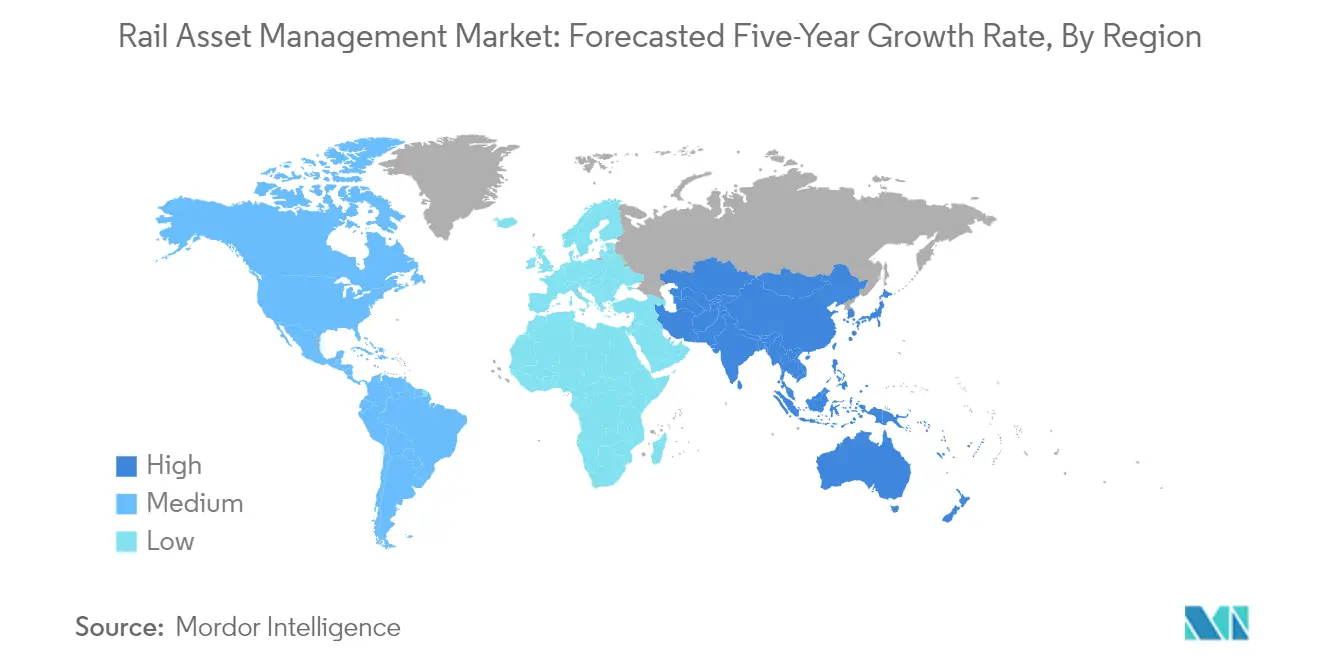
Rail Asset Management Market in the United States
The United States dominates the North American market with approximately 70% market share in 2024, establishing itself as the region's largest market. The country's extensive railway network and continuous investment in infrastructure modernization drive market growth. American rail operators are increasingly adopting cloud-based railroad asset management solutions and advanced analytics platforms to optimize their operations. The integration of Internet of Things (IoT) devices and artificial intelligence in rail asset management has become a key focus area, particularly in predictive maintenance and real-time monitoring applications.
Rail Asset Management Market in Canada
Canada emerges as the fastest-growing market in North America, with a projected growth rate of approximately 7% during 2024-2029. The country's commitment to sustainable transportation and railway modernization fuels this growth trajectory. Canadian rail operators are increasingly focusing on implementing advanced railway operations management solutions to enhance operational efficiency and safety. The country's emphasis on developing smart transportation infrastructure and the adoption of digital technologies in rail operations continue to create new opportunities for market expansion.
Rail Asset Management Market in Europe
The European rail asset management market showcases sophisticated development across its major economies, including Germany, France, and the United Kingdom. The region's strong emphasis on railway modernization and digital transformation initiatives creates a robust environment for advanced asset management solutions. European rail operators are particularly focused on implementing sustainable and efficient management practices, supported by strong regulatory frameworks and technological innovation.
Rail Asset Management Market in Germany
Germany leads the European market with approximately 28% market share in 2024, positioning itself as the region's largest market. The country's comprehensive rail network and strong industrial base support this market leadership. German rail operators are at the forefront of implementing advanced railroad asset management technologies, with particular emphasis on digitalization and automation. The country's focus on developing intelligent transportation systems and modernizing existing infrastructure continues to drive market growth.
Rail Asset Management Market in the United Kingdom
The United Kingdom demonstrates the highest growth potential in Europe, with a projected growth rate of approximately 6% during 2024-2029. The country's strategic focus on modernizing its rail infrastructure and improving operational efficiency drives this growth. British rail operators are increasingly adopting innovative railway operations management solutions, particularly in areas of predictive maintenance and real-time monitoring. The integration of digital technologies and smart solutions in rail operations continues to create new opportunities for market expansion.
Rail Asset Management Market in Asia-Pacific
The Asia-Pacific rail asset management market exhibits dynamic growth patterns across its major economies, including China, India, and Japan. The region's rapid urbanization and extensive railway infrastructure development create substantial opportunities for asset management solutions. Countries in this region are actively investing in modernizing their rail networks and implementing advanced management systems to improve operational efficiency and safety.
Rail Asset Management Market in China
China maintains its position as the largest market in the Asia-Pacific region, driven by its extensive railway network and continuous infrastructure expansion. The country's commitment to developing smart transportation systems and implementing advanced technologies in rail operations strengthens its market leadership. Chinese rail operators are increasingly focusing on digital transformation and the integration of innovative solutions in rolling stock management.
Rail Asset Management Market in India
India emerges as the fastest-growing market in the Asia-Pacific region, supported by its ambitious railway modernization initiatives and increasing adoption of digital solutions. The country's focus on improving operational efficiency and implementing advanced asset management systems drives market growth. Indian railways are actively embracing technological innovations and smart solutions to enhance their rolling stock management capabilities.
Rail Asset Management Market in Latin America
The Latin American rail asset management market demonstrates significant potential for growth, driven by increasing investments in railway infrastructure modernization and digital transformation initiatives. The region's focus on improving operational efficiency and safety through advanced asset management solutions creates new market opportunities. Brazil emerges as the largest market in the region, while Mexico shows the fastest growth potential, with both countries driving significant developments in rail asset management technologies and solutions.
Rail Asset Management Market in the Middle East & Africa
The Middle East & African rail asset management market shows promising development, supported by increasing investments in railway infrastructure and modernization initiatives. The region's focus on developing efficient transportation systems and implementing advanced asset management solutions drives market growth. Saudi Arabia emerges as the largest market in the region, while the United Arab Emirates demonstrates the fastest growth potential, with both countries actively investing in railway digitalization and smart transportation solutions.
Rail Asset Management Industry Overview
Top Companies in Rail Asset Management Market
The rail asset management market features prominent technology and industrial leaders, including Siemens, Hitachi, Alstom, IBM Corporation, Wabtec Corporation, SAP SE, Capgemini SE, Cisco Systems, Huawei Technologies, and Accenture PLC, among others. These companies are heavily investing in research and development to enhance their digital capabilities, particularly in areas like artificial intelligence, rail IoT integration, and predictive maintenance solutions. Strategic partnerships and collaborations with railway operators have become increasingly common as companies seek to strengthen their market positions and expand service offerings. The industry is witnessing a significant push toward cloud-based solutions and railway digital twin technology implementation, with vendors focusing on developing comprehensive end-to-end asset management platforms. Companies are also expanding their geographical presence through strategic acquisitions and establishing innovation centers in key markets to better serve local customers and adapt solutions to regional requirements.
Dynamic Market Structure Drives Industry Evolution
The rail asset management market exhibits a balanced mix of global technology conglomerates and specialized rail solution providers, creating a competitive environment that fosters innovation and service quality. Large multinational corporations leverage their extensive resources and cross-industry expertise to deliver integrated solutions, while specialized players maintain their edge through deep domain knowledge and focused rail sector expertise. The market is experiencing moderate consolidation through strategic acquisitions, particularly as larger players seek to acquire niche technology providers to enhance their digital capabilities and expand their solution portfolios.
The industry landscape is characterized by strong partnerships between solution providers and rail operators, creating high barriers to entry for new market participants. Market vendors are increasingly adopting vertical integration strategies, offering comprehensive solutions that span from basic maintenance management to advanced predictive analytics and optimization services. The competitive dynamics are further shaped by regional preferences and regulations, with local players maintaining strong positions in their home markets while global players leverage their international experience and technological capabilities to expand their presence.
Innovation and Integration Drive Future Success
Success in the rail asset management market increasingly depends on providers' ability to deliver integrated, scalable solutions that address the evolving needs of rail operators. Companies must focus on developing robust data analytics capabilities, enhancing cybersecurity measures, and ensuring seamless integration with existing railway infrastructure and systems. The ability to provide flexible deployment options, including both cloud-based and on-premises solutions, while maintaining high levels of service reliability and security, has become crucial for market success. Vendors must also demonstrate clear value propositions through improved operational efficiency, reduced maintenance costs, and enhanced asset lifecycle management.
Market players need to navigate complex regulatory environments while maintaining strong relationships with key stakeholders in the railway industry. The increasing focus on sustainability and environmental considerations presents both challenges and opportunities for solution providers to develop green technologies and energy-efficient asset management systems. Success also depends on providers' ability to address the growing demand for real-time monitoring and predictive maintenance capabilities, while managing the high switching costs and long-term nature of client relationships in the railway sector. Companies must balance innovation with reliability, ensuring that new technologies enhance rather than disrupt existing operations while maintaining competitive pricing strategies. Additionally, the implementation of railway analytics and rail tracking system solutions is becoming essential to meet the industry's demand for real-time data insights and operational efficiency.
Rail Asset Management Market Leaders
-
Siemens AG
-
Hitachi Ltd
-
Alstom
-
IBM Corporation
-
Wabtec Corporation
- *Disclaimer: Major Players sorted in no particular order
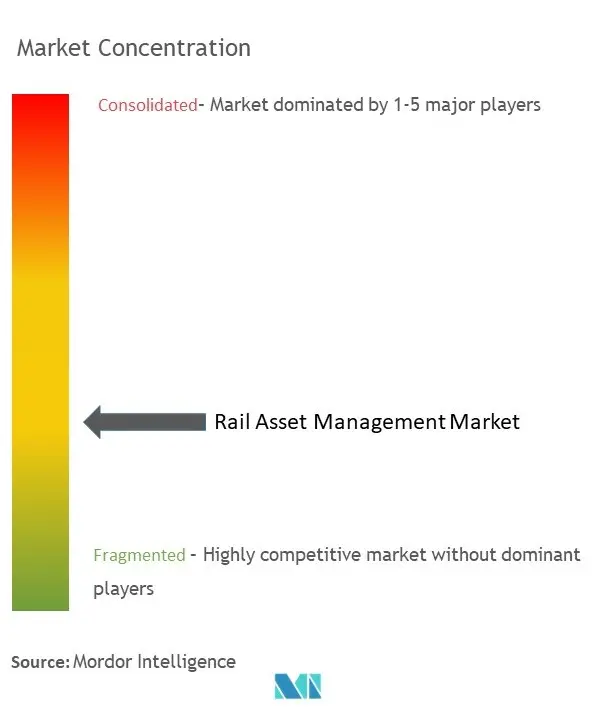
Rail Asset Management Market News
- April 2023: Alstom, a provider of smart and sustainable mobility, signed a contract with the Pomeranian Metropolitan Railway, a Pomeranian railway infrastructure management company, to provide full maintenance services, including repairs and periodic inspections of rail traffic control equipment manufactured at the Alstom ZWUS site.
- April 2023: Great Western Railway (GWR), Eversholt Rail, and Hitachi Rail extended their maintenance cooperation, bringing millions of pounds in investment to the UK supply chain and improving train service dependability for GWR customers. The decision to renew the contract was based on Hitachi Rail's past success, which has seen the fleet's dependability performance climb by more than 94% since its debut.
Rail Asset Management Market Report - Table of Contents
1. INTRODUCTION
- 1.1 Study Assumptions and Market Definition
- 1.2 Scope of the Study
2. RESEARCH METHODOLOGY
3. EXECUTIVE SUMMARY
4. MARKET INSIGHT
- 4.1 Market Overview
-
4.2 Industry Attractiveness- Porter's Five Forces Analysis
- 4.2.1 Bargaining Power of Suppliers
- 4.2.2 Bargaining Power of Buyers
- 4.2.3 Threat of New Entrants
- 4.2.4 Threat of Substitutes
- 4.2.5 Intensity of Competitive Rivalry
- 4.3 Assessment of the Impact of COVID-19 on the Market (by Major Countries)
-
4.4 Technology Outlook
- 4.4.1 Increasing Demand for Advanced Transportation Infrastructure
- 4.4.2 Smart Cities Gaining Traction
- 4.5 Rail Infrastructure Investment Outlook (Provides Coverage on Major Countries' Spending on Railway Infrastructure)
5. MARKET DYNAMICS
-
5.1 Market Drivers
- 5.1.1 Growing Demand for Effective Rail Operations
- 5.1.2 Increase in Government Initiatives and Public-Private Partnership Model
- 5.1.3 Rapid Urbanization in Developing and Underdeveloped Countries
-
5.2 Market Challenges
- 5.2.1 High Initial Deployment Costs
- 5.2.2 Difficulties with Legacy Infrastructure Integration
6. MARKET SEGMENTATION
-
6.1 By Deployment
- 6.1.1 On-Premises
- 6.1.2 Cloud
-
6.2 By Application
- 6.2.1 Rolling Stock
- 6.2.2 Infrastructure
-
6.3 By Geography***
- 6.3.1 North America
- 6.3.1.1 United States
- 6.3.1.2 Canada
- 6.3.2 Europe
- 6.3.2.1 United Kingdom
- 6.3.2.2 France
- 6.3.2.3 Germany
- 6.3.3 Asia
- 6.3.3.1 China
- 6.3.3.2 India
- 6.3.3.3 Japan
- 6.3.4 Australia and New Zealand
- 6.3.5 Latin America
- 6.3.6 Middle East and Africa
7. COMPETITIVE LANDSCAPE
-
7.1 Company Profiles*
- 7.1.1 Siemens AG
- 7.1.2 Hitachi Ltd.
- 7.1.3 Alstom
- 7.1.4 IBM Corporation
- 7.1.5 Wabtec Corporation
- 7.1.6 SAP SE
- 7.1.7 Capgemini SE
- 7.1.8 Cisco Systems Inc.
- 7.1.9 Huawei Technologies Co.
- 7.1.10 Accenture PLC
- 7.1.11 Trimble Inc.
- 7.1.12 Bentley Systems Incorporated
- 7.1.13 SNC-Lavalin Group Inc.
- 7.1.14 ZEDAS GmbH
8. INVESTMENT ANALYSIS
9. MARKET OPPORTUNITIES AND FUTURE TRENDS
Rail Asset Management Industry Segmentation
The rail asset management market is defined based on the revenues generated from the various solutions and services that are being used in applications worldwide. The analysis is based on the market insights captured through secondary research and primary. The report also covers the major factors impacting the market's growth in terms of drivers and restraints. The scope of the study has been segmented based on the deployment (on-premises and cloud) and application (rolling stock and infrastructure) around the world.
The Rail Asset Management Market is segmented By Deployment (On-Premises, Cloud), By Application (Rolling Stock, Infrastructure), and By Geography (North America(United States, Canada), Europe (United Kingdom, France, Germany, Rest of Europe), Asia-Pacific (China, Japan, India, Rest of Asia-Pacific), Latin America, Middle East & Africa). The report offers market forecasts and size in value (USD) for all the above segments.
| By Deployment | On-Premises | ||
| Cloud | |||
| By Application | Rolling Stock | ||
| Infrastructure | |||
| By Geography*** | North America | United States | |
| Canada | |||
| Europe | United Kingdom | ||
| France | |||
| Germany | |||
| Asia | China | ||
| India | |||
| Japan | |||
| Australia and New Zealand | |||
| Latin America | |||
| Middle East and Africa | |||
Rail Asset Management Market Research FAQs
How big is the Rail Asset Management Market?
The Rail Asset Management Market size is expected to reach USD 13.43 billion in 2025 and grow at a CAGR of 6.07% to reach USD 18.03 billion by 2030.
What is the current Rail Asset Management Market size?
In 2025, the Rail Asset Management Market size is expected to reach USD 13.43 billion.
Who are the key players in Rail Asset Management Market?
Siemens AG, Hitachi Ltd, Alstom, IBM Corporation and Wabtec Corporation are the major companies operating in the Rail Asset Management Market.
Which is the fastest growing region in Rail Asset Management Market?
Asia Pacific is estimated to grow at the highest CAGR over the forecast period (2025-2030).
Which region has the biggest share in Rail Asset Management Market?
In 2025, the Europe accounts for the largest market share in Rail Asset Management Market.
What years does this Rail Asset Management Market cover, and what was the market size in 2024?
In 2024, the Rail Asset Management Market size was estimated at USD 12.61 billion. The report covers the Rail Asset Management Market historical market size for years: 2019, 2020, 2021, 2022, 2023 and 2024. The report also forecasts the Rail Asset Management Market size for years: 2025, 2026, 2027, 2028, 2029 and 2030.
Our Best Selling Reports
Rail Asset Management Market Research
Mordor Intelligence provides comprehensive insights into the rail asset management industry. We leverage our extensive experience in railroad asset management research and consulting. Our detailed analysis covers emerging technologies, including rail IoT solutions, railway digital twin implementations, and rail predictive maintenance systems. The report, available as a PDF for easy download, offers in-depth coverage of rail infrastructure management practices and rail tracking system innovations. This provides stakeholders with a complete view of industry developments and technological advancements.
Our analysis benefits industry participants by examining crucial aspects of railway operations management and rail fleet management. It provides detailed insights into railway analytics and railway condition monitoring solutions. The report explores rolling stock management strategies and rail facilities management practices, incorporating the latest trends in rail maintenance software. Stakeholders gain valuable understanding of how these technologies integrate to optimize operations. There is particular emphasis on the evolving landscape of rolling stock management market dynamics and the expanding rail asset management market.

